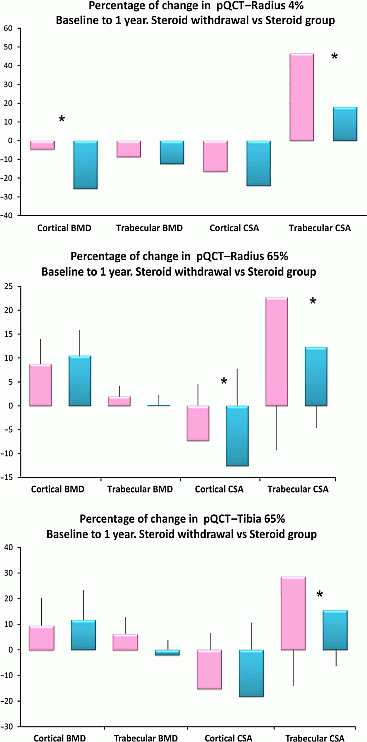ICCBH2013 Poster Presentations (1) (201 abstracts)
Randomized-controlled study in kidney transplanted children: early corticoids withdrawal and effect on bone health recovery
Maria Loreto Reyes 1 , Verónica Mericq 2 , Paulina Salas 3 , Viola Pinto 3 , Francisco Cano 4 , Magdalena González 6 , Keenan Brown 5 & Angela Delucchi 4
1Unit of Pediatric Endocrinology, Pontificia Universidad Católica de Chile, Santiago, Chile; 2Institute of Maternal and Child Research, University of Chile, Santiago, Chile; 3Pediatric Nephrology Unit, Hospital Excequiel Gonzalez Cortes, Santiago, Chile; 4Pediatric Nephrology Unit, Hospital Luis Calvo Mackenna, Santiago, Chile; 5Mindways Software, Austin, Texas, USA; 6Institute of Biomedical Sciences, University of Chile, Santiago, Chile.
Background: Glucocorticoid immune suppression in kidney transplanted children jeopardizes optimal bone health recovery. So far, there are no studies that evaluate the effect of transplant and corticoid in bone parameters separately.
Objective: To determine the effect of early corticosteroid withdrawal in bone parameters.
Methods: Randomized, controlled study; two groups: corticosteroid withdrawal (at the 6th day post-transplant, then tacrolimus/mycophenolate; CW) and corticosteroids (C). Evaluations: PTH, 25OH and 1,25 (OH)2 vitamin D, bone turnover markers, Klotho, FGF-23, IGF1, IGFBP3, pQCT (radius 4% and tibia y radio 65%) at baseline and 12 months post-transplant.
Results: Thirty patients: 14 CW and 16 SC, age: 7.8±4.3 years, 17 males. Significantly, there was a decrease in PTH, increase in IGF1; IGFBP3; 25OHD, bone specific alkaline phosphatase. Acid phosphatases increase only in C group (Fig. 1).

Figure 1 Percentage changes in pQCT variables (mean and S.E.M.). Rose bars, corticoid withdrawal; blue bars, corticoid group. *P<0.05. In all sites, cortical cross sectional area (CSA) decreases and trabecular CSA increases, significantly more in the C group.
Cortical bone mineral density (BMD) decreases in both groups significantly at the 4% radius, and tends to increase at the 65% tibia and 65% radius. These increases correlate positively with IGF1 and lean mass. In both groups, 4% radius changes, in trabecular and cortical BMD and CSA correlate with changes in height-SD, bone turnover markers and PTH. In 65% radius and tibia, increase in trabecular CSA correlated positively with height–S.D., IGF1 and 25OHD. In both groups, FGF-23 and Klotho decrease. Klotho correlates negatively with trabecular CSA in 4% radius and 25OHD.
Conclusions: Transplant produces significant changes in pQCT and turnover markers independently of corticoids. These changes are more favorable when corticosteroids are removed earlier.
Supported by Fondecyt 1080166. https://register.clinicaltrials.gov (IDr: NCT00707759).
 }
}



